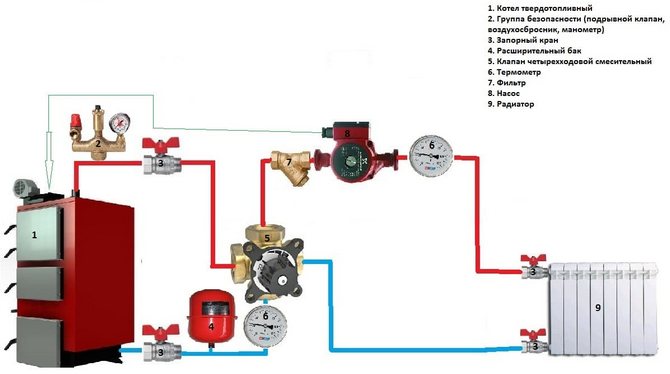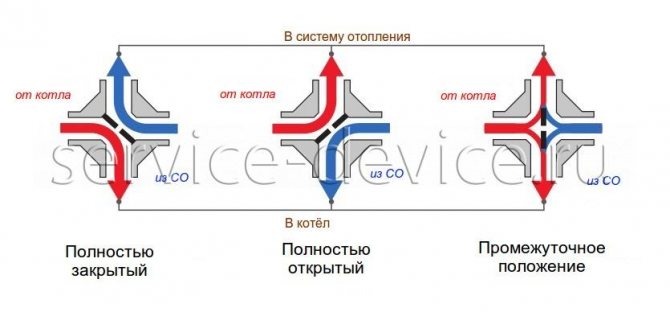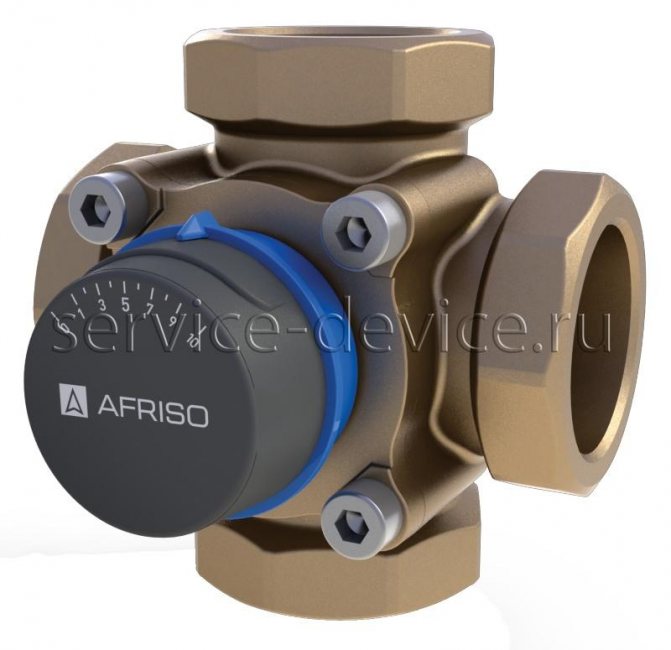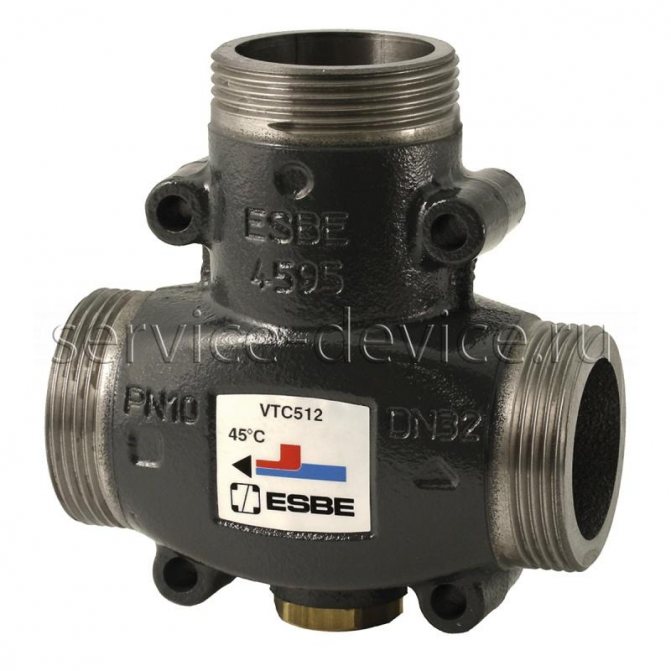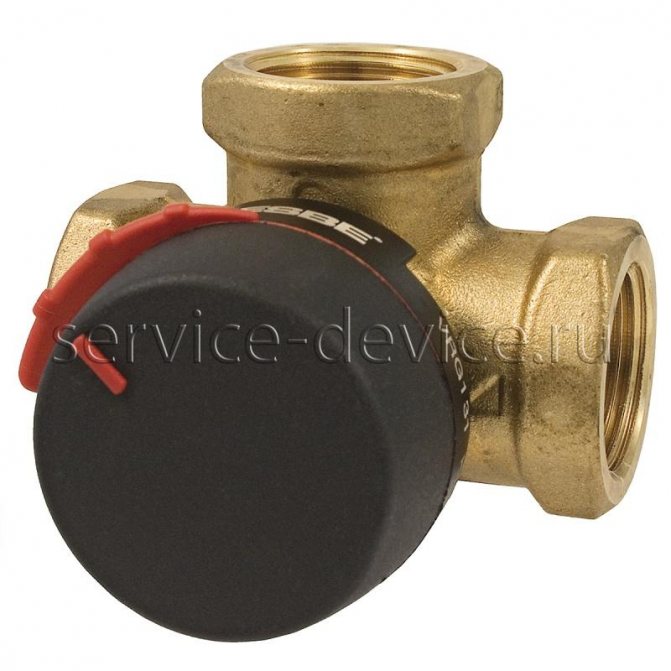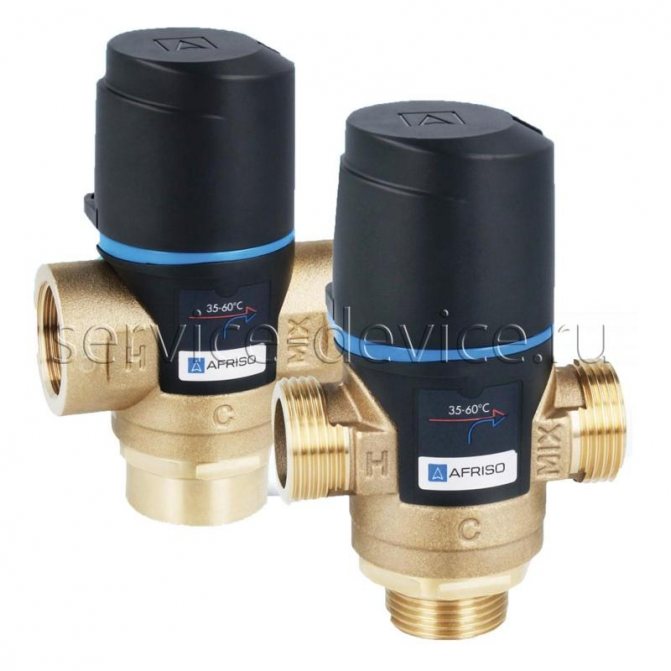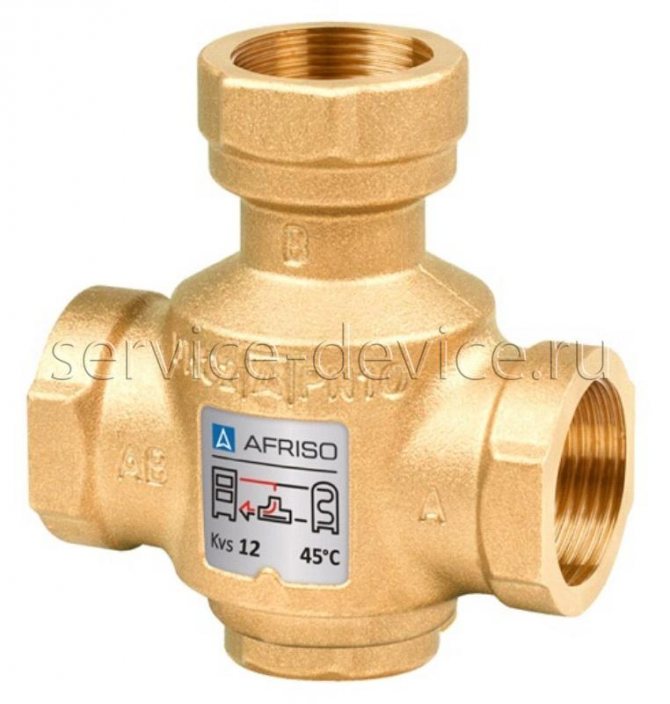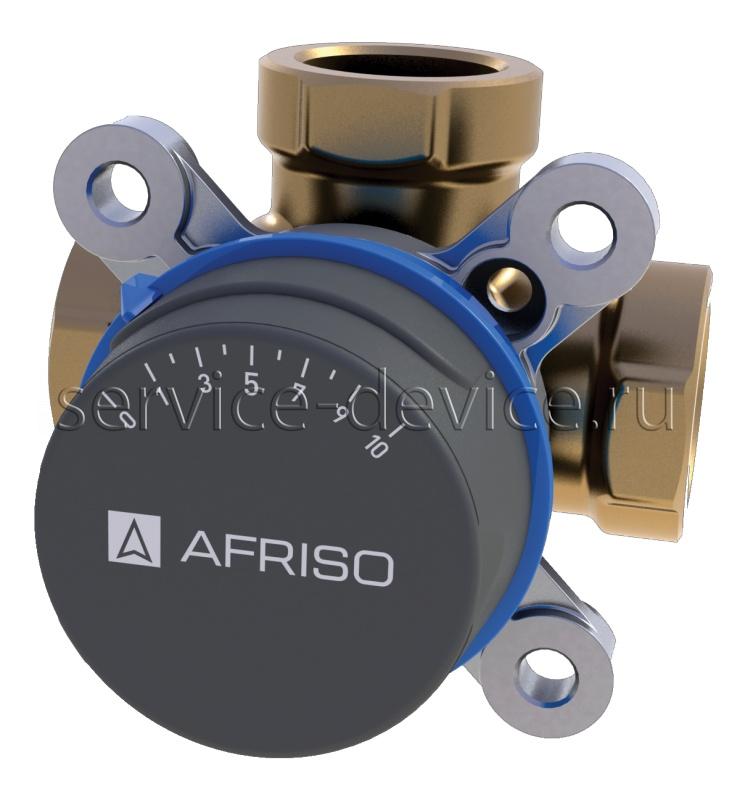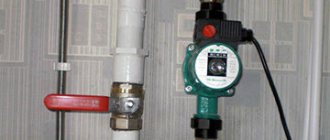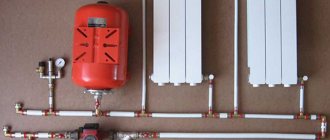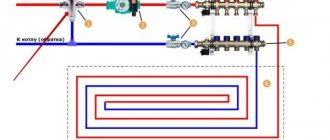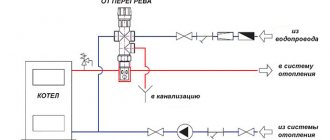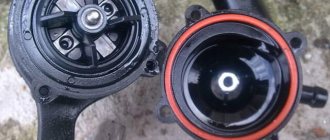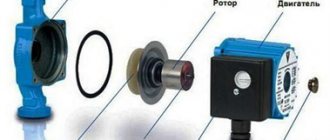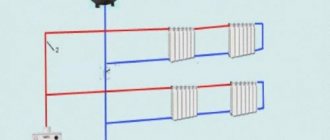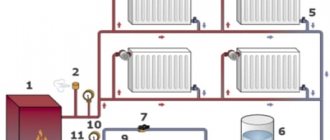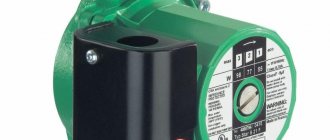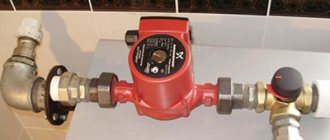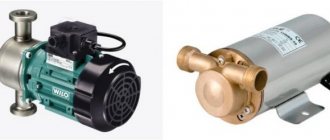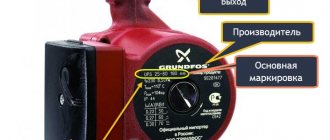Manufacturers
The four-way valve for heating is manufactured by companies such as Honeywell, ESBE, VALTEC and others.
Today it is a manufacturer that is included in the list of the world's 100 leading firms, compiled by Fortune magazine.
Honeywell four-way valve
Four-way valves Honeywell V5442A series are made for systems where water or liquid acts as a heat carrier, with a glycol percentage of up to 50. They are designed to operate at temperatures from 2 to 110 ° C and at an operating pressure of up to 6 bar.
Honeywell manufactures valves with connection sizes 20, 25, 32 mm. Therefore, the values of the Kvs coefficient are from 4 to 16 m³ / h. Devices of the series work together with electric drives. For systems with higher capacities, the flanged valve series ZR-FA is used.
The Honeywell four-way valve is easy to install, there are many options available.
All its products are economical, reliable and convenient for use in heating, cooling and water supply systems.
ESBE offers a 4-way heating valve with female thread. The valve body is made of brass. Working pressure 10 atmospheres, temperature 110 degrees (short-term - 130 degrees). The four-way mixing valve is manufactured in sizes 1 / 2-2 ", with a capacity of 2.5 -40 Kvs.
Valtek offers mixing valves for various purposes, which are designed for long-term operation in the engineering system (water underfloor heating, built-in wall, ceiling heating and cooling, hot water supply). The manufacturer's products can be found anywhere in Russia and the CIS countries.
It cannot be argued that a four-way valve for heating will not require financial investments. Installation of the device will be expensive, however, on the other hand, the efficiency of the work and, as a result, the economy, justifies the monetary costs. There is only the main condition - the presence of a high-quality electrical network, since without it the valve drive will stop working.
This allows some automation of control, however, it does not make it possible to constantly maintain a certain temperature at the boiler inlet (which is necessary for the safety and durability of the heat generator). Indeed, with large temperature drops, there is a possibility of condensation formation with subsequent corrosion of the heat exchanger, and the intensity of scale formation also increases. If a cast iron heat exchanger is used, cracks may appear in the heat exchanger sections. In addition, the stress on the joints of the boiler parts increases, primarily at the joints and along the welded seams.
Therefore, for the safety of operation and durability of the equipment, as well as achieving the required level of comfort, four-way valves are used to separate the heating and boiler circuits. In fig. 2 shows a typical scheme using a solid fuel boiler and a DHW storage tank (one exit from the boiler, after which the coolant is distributed to heating hot water and the heating system). The separation of the boiler circuit and the heating circuit is carried out using a 4-way valve, which allows a constant circulation in the boiler and, at the same time, in the heating circuit.
Fig. 2. Installation diagram of a solid fuel boiler to a heating system with forced circulation of the coolant and a 4-way valve:1 - boiler; 2 - boiler control automation unit; 3 - coolant temperature sensor; 4 - room thermostat; 5 - circulation pump; 6 - heat consumer; 7 - differential valve; 8 - four-way mixing valve; 9 - expansion tank; 10 - hot water boiler; 11 - boiler pump; 12 - shutoff valves; 13 - filter
At the same time, in addition to the extreme positions, in the middle position, 50% of the coolant goes to the heating system, mixing with 50% of the coolant returning from the heating system, and the rest returns back to the boiler, mixing with the rest of the coolant from the heating system. It is also possible to maintain, in contrast to regulation with 3-way valves, the flow separation constant and in other strictly defined proportions. For example, 30% of the coolant is in the boiler circuit, 70% is in the heating system. Or any other ratio (fig. 3).
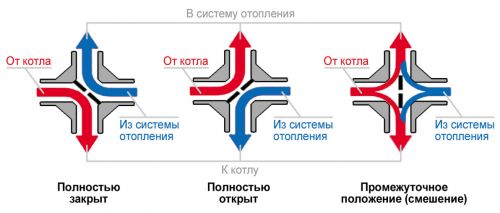
Fig. 3. Positions of the 4-way valve
Such a constant flow rate is very important for a solid fuel boiler, since, as we noted above, when using it, there are not such wide opportunities to influence the intensity of the combustion process as in gas boilers. The use of an automatic draft regulator allows you to regulate the temperature only at the outlet from the boiler, but not on the return line
Practical use
Wherever it is necessary to ensure high-quality regulation of the coolant, four-way valves can be used. Quality control is the control of the temperature of the coolant, not its flow rate. There is only one way to achieve the required temperature in the water heating system - by mixing hot and cooled water, obtaining a coolant with the required parameters at the outlet. The success of this process is precisely what ensures the device of the four-way valve. Here are a couple of examples of setting an element for such cases:
- in a radiator heating system with a solid fuel boiler as a heat source;
- in the underfloor heating circuit.
As you know, a solid fuel boiler in the heating mode needs protection from condensation, from which the walls of the furnace are subject to corrosion. The traditional arrangement with a bypass and a three-way mixing valve that prevents cold water from the system from entering the boiler tank can be improved. Instead of a bypass line and a mixing unit, a four-way valve is installed, as shown in the diagram:
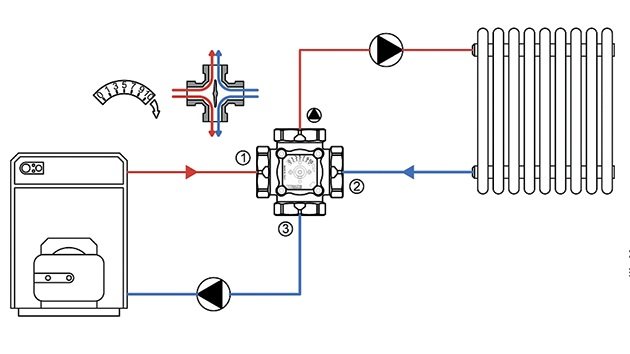
A natural question arises: what is the use of such a scheme, where you have to install a second pump, and even a controller to control the servo drive? The fact is that here the operation of the four-way valve replaces not only the bypass, but also the hydraulic separator (hydraulic arrow), if there is a need for one. As a result, we get 2 separate circuits that exchange coolant with each other as needed. The boiler is dosed with chilled water, and the radiators receive the coolant with the optimum temperature.
Since the water circulating along the heating circuits of the underfloor heating heats up to a maximum of 45 ° C, it is unacceptable to run the coolant in them directly from the boiler. In order to withstand this temperature, a mixing unit with a three-way thermostatic valve and a bypass is usually installed in front of the distribution manifold. But if, instead of this unit, a four-way mixing valve is installed, then return water from the radiators can be used in the heating circuits, as shown in the diagram:
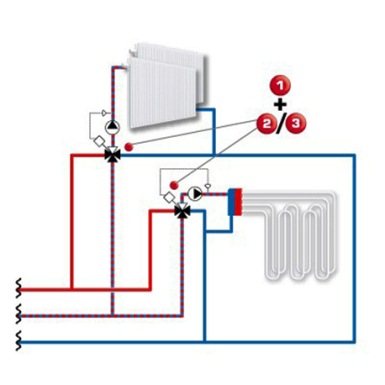

Heating with four-way valve
Installation of a heating system with a four-way valve:
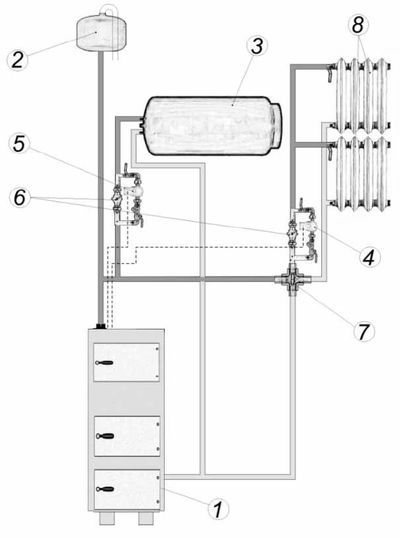

The heating system connection diagram with a four-way mixer consists of the following elements:
- Boiler;
- Four-way thermostatic mixer;
- Safety valve;
- Reducing valve;
- Filter;
- Ball valve;
- Pump;
- Heating batteries.
The installed heating system must be flushed with water. This is necessary so that various mechanical particles are removed from it. After that, the boiler operation must be checked at a pressure of 2 bar and with the expansion vessel turned off.
It should be noted that a short period of time must elapse between the start of the full operation of the boiler and its check under hydraulic pressure. The time limit is due to the fact that with a long absence of water in the heating system, it will corrode
A four-way valve is an element of the heating system, to which four pipes are connected, having heat carriers of different temperatures, is used to prevent overheating of a solid fuel boiler. The thermostatic valve prevents the temperature inside the boiler from exceeding 110 ° C. Already at a temperature of 95 ° C, it starts cold water to cool the system.
Four-way valve design
The body is made of brass, 4 connecting pipes are attached to it. Inside the body there is a bushing and a spindle, the operation of which has a complex configuration.
The thermostatic mixing valve performs the following functions:
- Mixing water streams of different temperatures. Thanks to mixing, smooth regulation of water heating works;
- Boiler protection. The four-way mixer prevents corrosion, thus extending the life of the equipment.
Four-way mixer circuit
The principle of operation of such a valve for heating is to rotate the spindle inside the body. Moreover, this rotation should be free, since the sleeve has no thread. The working part of the spindle has two cuts through which the flow is opened in two passes. Thus, the flow will be regulated and will not be able to go directly to the second sample. The flow will be able to turn into any of the nozzles located on the left or right side of it. So, all streams coming from opposite sides are mixed and distributed over four nozzles.
There are designs in which a push rod works instead of a spindle, but such devices cannot mix flows.
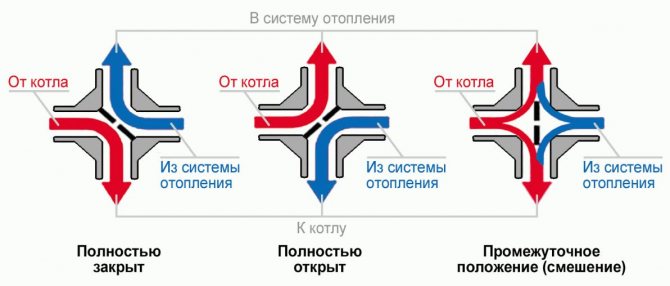

The valve is controlled in two ways:
- Manual. Distribution of flows requires the installation of the stem in one specific position. You need to adjust this position manually.
- Auto. The spindle rotates as a result of a command received from an external encoder. In this way, the set temperature is constantly maintained in the heating system.
The four-way mixing valve ensures a stable flow of cold and hot heating medium. The principle of its operation does not require the installation of a differential bypass, because the valve itself passes the required amount of water. The device is used where temperature control is required. First of all, it is a radiator heating system with a solid fuel boiler. If in other cases the regulation of heat carriers occurs with the help of a hydraulic pump and a bypass, then here the operation of the valve completely replaces these two elements. As a result, the boiler operates in a stable mode, constantly receiving a dosed amount of coolant.
Heating with four-way valve
Installation of a heating system with a four-way valve:
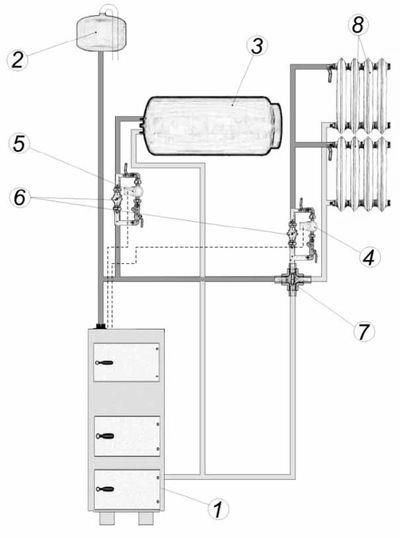

The connection diagram of a heating system with a four-way mixer consists of the following elements:
- Boiler;
- Four-way thermostatic mixer;
- Safety valve;
- Reducing valve;
- Filter;
- Ball valve;
- Pump;
- Heating batteries.
The installed heating system must be flushed with water. This is necessary so that various mechanical particles are removed from it. After that, the boiler operation must be checked at a pressure of 2 bar and with the expansion vessel turned off.
It should be noted that a short period of time must elapse between the start of the full operation of the boiler and its check under hydraulic pressure.The time limit is due to the fact that with a long absence of water in the heating system, it will corrode
How to make a heating system with a four-way valve
Conclusions and useful video on the topic
The nuances of the installation, taking into account which guarantees the correct operation of the valve:
Details of valve installation when installing underfloor heating:
Such a unit in the heating system as a thermostatic three-way valve is necessary, but not in all cases. Its presence is a guarantee of the rational use of the coolant, which allows you to economically consume fuel. Additionally, it also acts as a device that ensures the safety of the boiler TT operation.
Nevertheless, before purchasing such a device, you must first consult about the advisability of its installation.
If you have the necessary experience or knowledge on the topic of the article and you can share it with visitors to our site, please leave your comments, ask questions in the block below.
Anyone who has ever tried to study various schemes of heating systems has probably come across such where the supply and return pipelines miraculously converge together. In the center of this node there is a certain element, to which pipes with a coolant of different temperatures are connected from four sides. This element is a four-way valve for heating, the purpose and operation of which will be discussed in this article.
Morphological parsing of the word four-way
FOUR-WAY
- inanimate
FOUR-WAY
- animate
Basic word form:
FOUR-WAY
All forms of a word with grammatical information:
| Word | Information |
| FOUR-WAY | singular, nominative, masculine, inanimate, animate |
| FOUR-WAY | accusative, singular, masculine, inanimate |
| FOUR-WAY | singular, feminine, inanimate, animate, genitive |
| FOUR-WAY | dative, singular, feminine, inanimate, animate |
| FOUR-WAY | singular, feminine, inanimate, animate, instrumental |
| FOUR-WAY | singular, feminine, inanimate, animate, prepositional |
| FOUR-WAY | singular, masculine, inanimate, animate, genitive |
| FOUR-WAY | accusative, singular, masculine, animate |
| FOUR-WAY | singular, inanimate, animate, genitive, neuter |
| FOUR-WAY | dative, singular, masculine, inanimate, animate |
| FOUR-WAY | dative, singular, inanimate, animate, neuter |
| FOUR-WAY | singular, masculine, inanimate, animate, instrumental |
| FOUR-WAY | singular, inanimate, animate, neuter, instrumental |
| FOUR-WAY | dative, plural, inanimate, animate |
| FOUR-WAY | singular, masculine, inanimate, animate, prepositional |
| FOUR-WAY | singular, inanimate, animate, prepositional, neuter |
| FOUR-WAY | singular, feminine, nominative, inanimate, animate |
| FOUR-WAY | accusative, singular, feminine, inanimate, animate |
| FOUR-WAY | singular, feminine, inanimate, animate, instrumental |
| FOUR-WAY | singular, nominative, inanimate, animate, neuter |
| FOUR-WAY | accusative, singular, inanimate, animate, neuter |
| FOUR-WAY | nominative, plural, inanimate, animate |
| FOUR-WAY | accusative, plural, inanimate |
| FOUR-WAY | plural, inanimate, animate, genitive |
| FOUR-WAY | accusative, plural, animate |
| FOUR-WAY | plural, inanimate, animate, prepositional |
| FOUR-WAY | plural, inanimate, animate, instrumental |
| FOUR-WAY | inanimate, animate, comparative (for adjectives) |
| FOUR-WAY | inanimate, animate, comparative (for adjectives) |
| HONORARY FOUR-WAY | second genitive or second prepositional, inanimate, animate, comparative (for adjectives) |
| HONOR FOUR-WAYS | second genitive or second prepositional, inanimate, animate, comparative (for adjectives) |
Popular manufacturers
There are many manufacturers of three-way valves on the domestic market. The choice of this or that model depends, first of all, on:
- the type of mechanism (and, we recall, it can be mechanical or electrical);
- areas of use (hot water supply, cold water supply, "warm floor", heating).
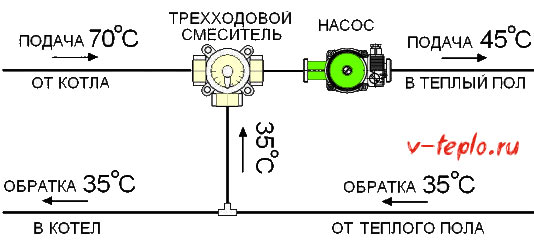

The most popular device is rightfully considered Esbe
- a Swedish valve from a company that has existed for over a hundred years. It is a reliable, high-quality and durable product that has proven itself in many areas. Combination of European quality and modern technologies.
Another popular model is the American Honeywell - a true brainchild of high technology. Simple operation, convenience and comfort, compactness and reliability - these are the distinctive features of these valves.
Finally, relatively "young" but promising devices are Valtec valves - the result of a joint collaboration between Italian and Russian engineers. All products are of high quality, sold with a seven-year warranty. They differ in that they have a completely affordable cost.
Valve classification
Without prolonged injections, we note that the device can be of two types according to the principle of operation. It can be:
- separating;
- mixing.
The features of the action of each type are clear already from their name. The mixing device consists of two outlets and an inlet. In other words, it is necessary for mixing liquid streams, which may be required in order to lower its temperature. By the way, this is the most optimal option in order to set the desired mode in the "warm floor".
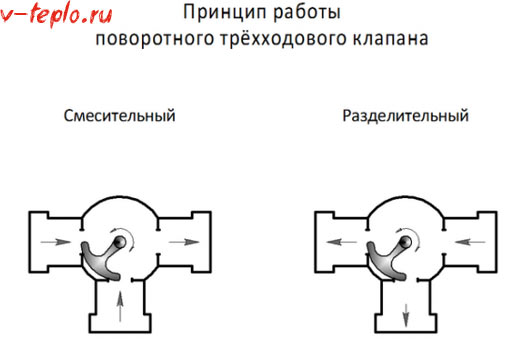

The very procedure for adjusting the temperature regime is extremely simple. You just need to know about the current temperature indicators of the incoming fluid flows, accurately calculate the required proportions of each of them so as to obtain the required indicators at the output. By the way, this device, subject to proper installation and adjustment, is able to function and split the flow.
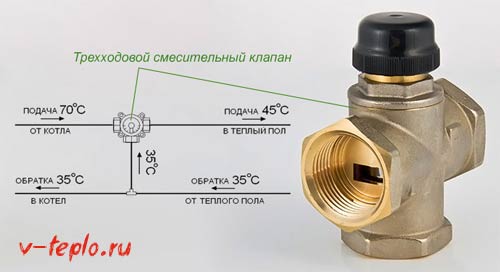

But the split valve divides one flow in two, therefore, it is equipped with one inlet and two outlets. This device is mainly used to divide the flow of hot water in DHW systems. Although quite often it is found in the piping of air heaters.
Outwardly, both options are almost identical. But if you look at their sectional drawing, then their main difference can be seen immediately. The stem, which is installed in the mixing-type device, has one ball valve. It is centered and overlaps the main passage.
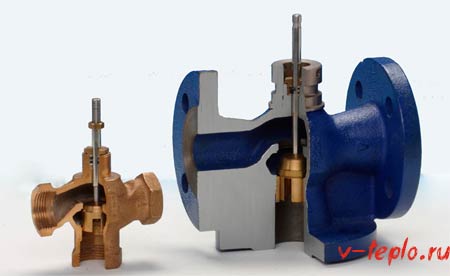

As for the separating devices, then the stem in them has two such valves, which are installed at the outputs. They function according to the following principle: one of them is pressed against the seat, closing the passage, and the other, in parallel with this, opens passage No. 2.
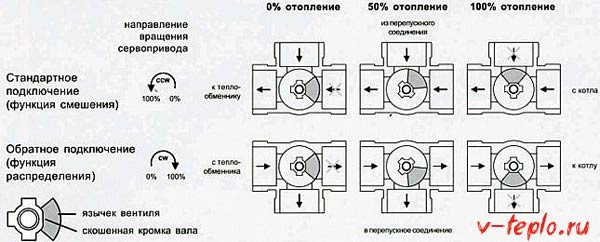

According to the control method, modern models can be:
- electric;
- manual.
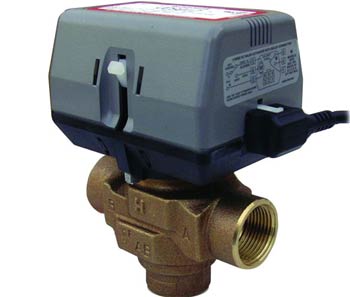

In most cases, a hand-held device is used, which outwardly resembles an ordinary ball valve, but is equipped with three outlet pipes.But electrical models with automatic control are used mainly in private houses, namely, in order to distribute heat. For example, the user can adjust the temperature regime for rooms, and the working fluid will flow in accordance with the distance between the room and the heater. Alternatively, you can combine it with a "warm floor".
Video - The device in the boiler group
Three-way valves, like other devices, are determined according to the system pressure and inlet diameter. All this is regulated by GOST. And if the requirements of the latter are not met, this will be regarded as a gross violation, especially when it comes to the pressure indicator in the line.
Where are 3-way valves used?
There are valves of this type in different schemes. They are included in the wiring diagram of underfloor heating to ensure uniform heating of all its sections and to exclude overheating of individual branches.
In the case of a solid fuel boiler, condensation is often observed in its chamber. The installation of a three-way valve will help to deal with it.
A three-way device in the heating system works effectively when there is a need to connect a DHW circuit and separate heat flows.
The use of a valve in the piping of radiators eliminates the need for a bypass. Installing it on the return line creates conditions for a short circuit device.
Repair of the Tadiran air conditioner. Replacing the four-way valve in the Tadiran air conditioner
Consider replacing the four-way valve in the Tadiran air conditioner, as well as the possibility of adapting the four-way valve used from another air conditioner. By tradition, we install the external unit of the air conditioner on the stand and check the parameters. If the valve is faulty, the following problems are detected:
The air conditioner does not switch to heating mode,
The air conditioner does not switch to cooling mode,
· The compressor is running, but nothing happens (no heating, no cooling on any of the radiators). In this case, most often there is a strong hiss in the external unit.
In this case, it does not switch to heating mode. We disassemble the external unit and pump out the old freon into the freon cylinder used.
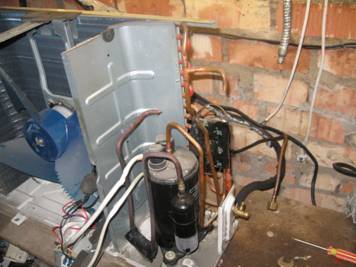

Next, I propose to simply bite off the pipes going to the four-way valve with side cutters. The old valve has been removed. Next, I propose to figure out why we are installing a bu valve, and not a new one. The valve has a simple device and it is not difficult or expensive to purchase it, but installation will take a lot of time. Inside the valve, the moving element is a stem made of plastic, and the connecting tubes are no more than 5 cm long, therefore, during soldering, the valve must be cooled, otherwise the stem will melt and the valve will fail. In addition, the soldering seams are inverted and the soldering occurs upside down, and for this it is necessary to evaporate all the tubes and the compressor, i.e. unsolder and solder back the entire air conditioner. I am against unnecessary soldering operations, since this leads to the formation of scale inside the tubes, and the scale is washed out only under the conditions of the manufacturer's plant. We try on a valve with pipes at the installation site, I was lucky - the valve turned out to be complete with a service suction port, we will apply it. We are planning three soldering seams.
Next, I cut the pipes to size and a suitable pipe from the bottom, we pass it with a pipe expander of the appropriate size. Next, we perform soldering with an oxygen torch and a solder with a silver content. In the photo, the discharge pipe of the compressor. We also bend, expand and solder the suction tube of the compressor.
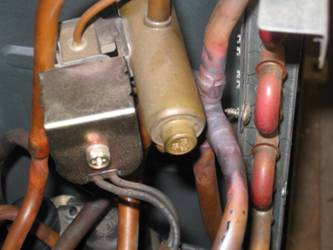

The inlet pipe of the condenser (radiator of the outdoor unit) is soldered without expansion directly into the tee, pre-bent. A very important point - the pipes should not touch each other, as well as the housing and the compressor, for this we bend or even fasten with ties through a rubber shock absorber.
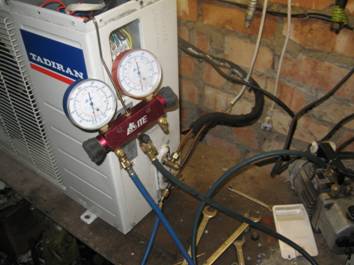

We assemble the body, attach the pipes of the stand, vacuum, fill with freon and check the operation of the entire external unit. https://www.youtube.com/watch?v=SGmvIKLB9I8
The operating parameters of the outdoor unit in heating and cooling mode are not ideal, but close to it. Let's summarize the work - disassembly, three soldering seams and four
How it works
The three-way valve is mounted on those sections of the highways where it is required to divide the flow of the circulating fluid into 2 circuits:
- with variable hydraulic mode;
- with constant.
In most cases, a constant flow is required for those who are supplied with high quality fluid and in the indicated volumes. It is regulated in accordance with the quality indicators. As for the variable flow, it is used for objects where quality indicators are not basic. There, the quantity ratio is of great importance. Simply put, the coolant is supplied there according to the required amount.
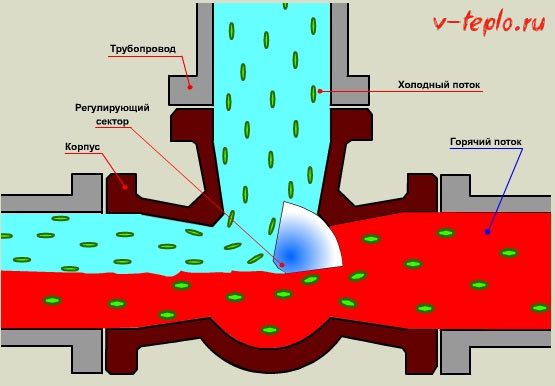

Note! An analogue of the device described in the article, a two-way valve, also belongs to the shut-off valves. How is it different? The fact is that the three-way option works according to a completely different principle.
The stem, which is part of its design, is unable to block the flow of fluid, which has constant hydraulic performance.
The stem is open all the time, it is adjusted to a particular volume of liquid. Consequently, users will be able to get the volume they need, both in terms of quantity and quality. In general, this device is unable to shut off the supply of fluid to a network in which the hydraulic flow is constant. In this case, the flow of a variable type, it can well shut off, due to which, in fact, it becomes possible to adjust the flow / pressure.
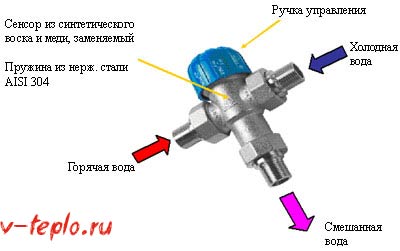

And if you connect a pair of two-way type devices, you can get one, but three-way. But it is necessary that both work in reverse, in other words, when one valve is closed, the next one should open.
The principle of operation and types of valves
The task of any 3-way valve is to supply water of the required temperature to the main by mixing or separating 2 streams. Accordingly, the element is equipped with three outputs, one of which is always open, and the other two completely or partially overlap during operation. Hence the name of the crane - three-way (sometimes they also say "three-way", which is not correct).
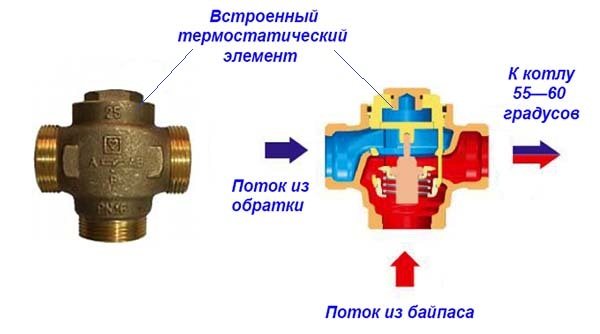

This is how mixing flows inside the product looks like.
Note. The heating circulation pump is always installed exactly on the side of the open outlet, otherwise the circuit will function incorrectly, as we wrote about earlier in another manual.
According to the method of preparing the coolant of the required temperature, the thermostatic valves are divided into 2 groups, shown in the photo:
- Mixing. They are supplied with 2 streams of water - hot and cooled (the inputs are designated by the letters "A" and "B"), and from the third branch pipe (marked "AB") there is a mixture of the set temperature. On the brass body there is a mark in the form of an arrow converging from two directions.
- Dividing or distribution. The incoming heat carrier is divided into 2 flows of controlled value. Marking on the body - 2 diverging arrows or letters "A", "B" on the outlet pipes and "AB" at the inlet.
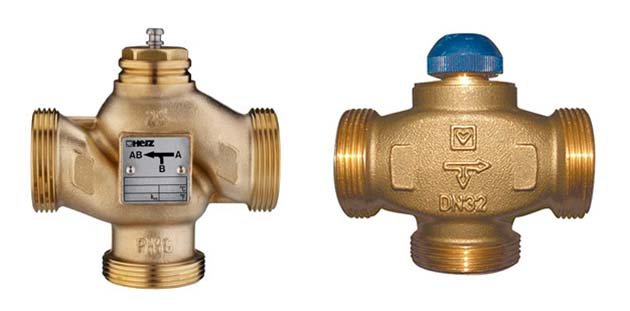

Mixing (left) and distribution (right) flow regulator
For reference. There is a third type of 3-way thermal valves - flap valves. They are installed in wall-mounted gas boilers with a water circuit and, using an electric drive, switch the flow between the main heating heat exchanger and the secondary one that provides hot water supply. Outside heat generators, such elements are rarely used.
According to the principle of operation, three-way valves are also divided into two types - saddle and ball valves.The device of the first is similar to ordinary water valves, only instead of a threaded rod, a pressure valve is used. A plate is fixed on it, moving between two seats and overlapping 2 passes alternately. The rod is pressed in three ways:
- built-in thermoelement
- thermal head with remote temperature sensor
- servo drive.
How this happens is shown in the diagram and detailed in our other publication.
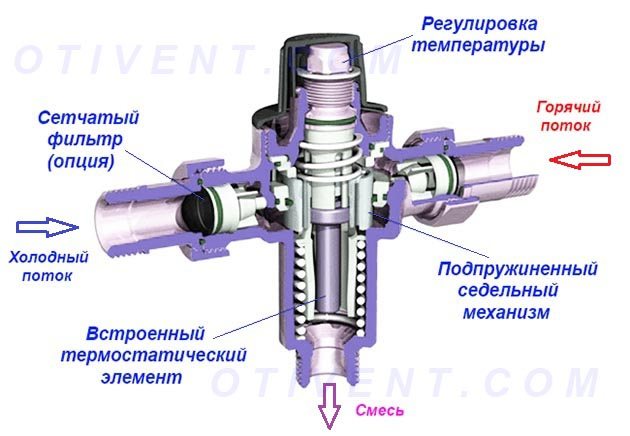

3-way valve design with manual temperature control and built-in thermocouple
Thermo-mixing ball valves work on the principle of the same valves, with only three outlets. They are controlled manually or from an electric drive that rotates the rod at the command of the automation. The elements are full bore and are characterized by high flow capacity, which means lower hydraulic resistance. The disadvantage is the dependence on the voltage in the mains and the need to install an uninterruptible power supply (UPS).
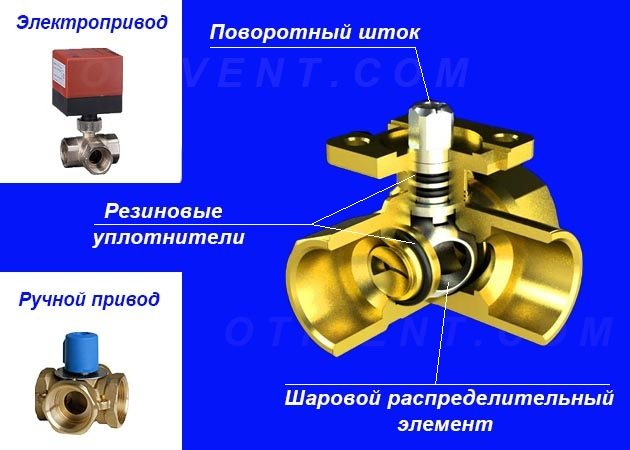

Rotary design with electric drive
How to install a DIY mixing valve
This installation scheme is used mainly in boiler rooms of those heating systems that are connected to a hydraulic separator or to a gravity collector. And the pump, located in the circuit No. 2, provides the required circulation of the working fluid.
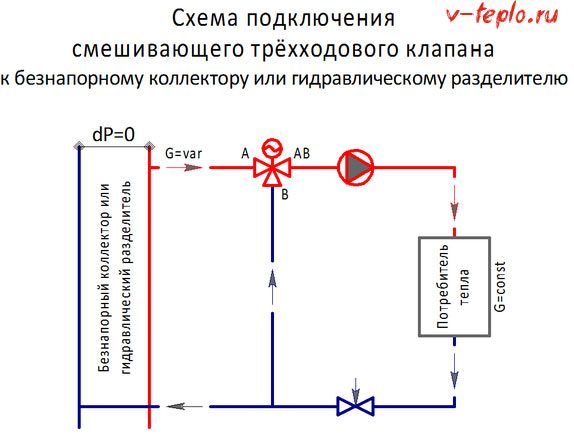

Note! If the three-way valve will be connected directly to a bypass source of thermal energy connected to port B, then a valve with a hydraulic resistance equal to the same resistance of this source will need to be installed.
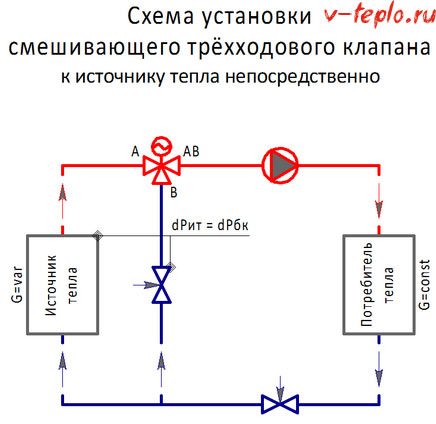

If this is not done, then the flow rate of the working fluid in the section AB will fluctuate in accordance with the movement of the rod. Note also that this installation scheme provides for the possible termination of the circulation of liquid through the source if the installation was made without a circulation pump or a hydraulic separator in the main circuit.
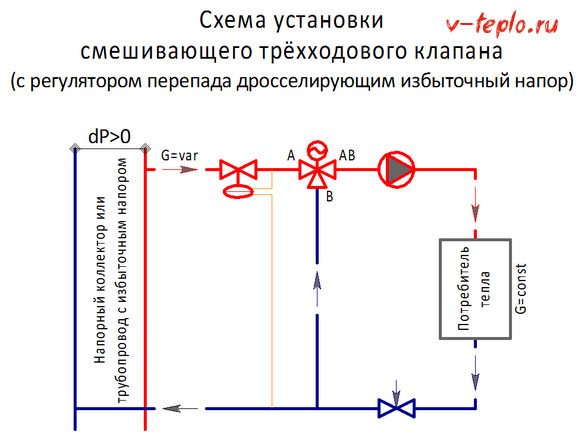

It is undesirable to connect the valve to heating systems or a pressure manifold in the absence of devices that throttle excessive pressure. Otherwise, the flow rate of the liquid in the section AB will fluctuate, and significantly.
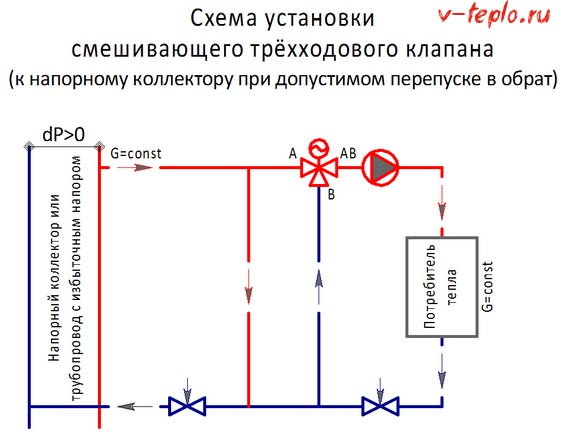

If overheating of the return is allowed, excessive pressure is disposed of by means of a jumper installed parallel to the valve mix in the circuit.
Features of product installation
During the installation of three-way valves, many nuances arise. The uninterrupted functioning of the heating system depends on their accounting. The manufacturer encloses instructions for each valve, the observance of which will subsequently avoid many troubles.
General installation guidelines
The main thing is to initially set the valve in the correct position, guided by the prompts indicated by the arrows on the body. Pointers indicate the path of the water flow.
A stands for direct travel, B stands for perpendicular or bypass direction, AB stands for combined input or output.
Based on the direction, there are two valve models:
- symmetrical or T-shaped;
- asymmetrical or L-shaped.
When mounted along the first of them, the liquid enters the valve through the end holes. Leaves through the center after mixing.
In the second variant, a warm stream enters from the end, and a cold stream enters from below. The liquid at different temperatures is discharged after mixing through the second end.
The second important point when installing the mixing valve is that it must not be positioned with the actuator or thermostatic head down. Before starting work, preparation is necessary: water is cut off in front of the installation point. Next, check the pipeline for the presence of residues in it that can cause the valve gasket to fail.
The main thing is to choose a place for installation so that the valve has access. It may have to be checked or dismantled in the future.All this requires free space.
Mixing valve insert
When inserting a three-way mixing valve into a district heating system, there are several options. The choice of the scheme depends on the nature of the connection of the heating system.
When, according to the operating conditions of the boiler, such a phenomenon as overheating of the coolant in the return is permissible, an overpressure necessarily arises. In this case, a jumper is mounted that throttles the excess head. It is installed parallel to the valve mix.
The diagram in the photo is a guarantee of high-quality regulation of the system parameters. If the three-way valve is connected directly to the boiler, which is most often the case in autonomous heating systems, a balancing valve insert is required.
If the recommendation for installing a balancing device is disregarded, significant changes in the flow rate of the working fluid, depending on the position of the stem, can occur in the AB port.
Connection according to the above diagram does not guarantee the absence of circulation of the coolant through the source. To achieve this, it is necessary to additionally connect a hydraulic isolator and a circulation pump to its circuit.
The mixing valve is also installed in order to separate the flows. The need for this arises when it is unacceptable to completely isolate the source circuit, but bypassing the liquid into the return is possible. Most often, this option is used in the presence of an autonomous boiler room.
Please be aware that vibration and noise may occur with some models. This is due to inconsistent flow directions in the pipeline and the mixing article. As a result, the pressure across the valve may drop below the permissible value.
Installation of the separating device
When the temperature of the source is higher than required by the consumer, a valve separating the flows is included in the circuit. In this case, at a constant flow rate both in the boiler circuit and by the consumer, overheated liquid will not come to the latter.
For the circuit to work, a pump must be present in both circuits.
Based on the above, general recommendations can be summarized:
- When installing any three-way valve, manometers are installed before and after it.
- To avoid the ingress of any impurities, a filter is mounted in front of the product.
- The body of the device must not be subjected to any stress.
- Good regulation must be ensured by inserting overpressure throttling devices in front of the valve.
- During installation, the valve must not be above the actuator.
It is also necessary to maintain in front of the product and after it the straight sections recommended by the manufacturer. Failure to comply with this rule will lead to a change in the declared technical characteristics. The device will not be covered by the warranty.

